- 09 SEPTEMBRE
- INDI-UNI : ANTHROPOLOGY - ARCHAEOLOGY
REGISTRATION 2011 – 2012 ONLINE COURSES
INSCRIPTION 2011 – 2012 COURS A DISTANCE
- ROYAUME UNI – 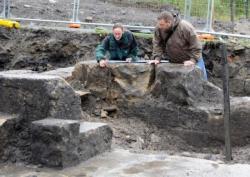 Todmorden - Buried secrets of Todmorden’s industrial past are being exposed to the light of day for the first time in more than 200 years. The foundations of the town’s first textile mill, started in 1782, will be uncovered before new flood defences are built over them. Preparation for the £13m spending on flood defences has already exposed the lower walls and floors of the old mill’s second phase of life, starting in the 1820s. The mill was originally water-powered but moved through coal-fired steam power to electricity. It was originally a woollens mill but started switching to cotton in 1787, following the Lancashire trend in response to imports of American cotton.By 1829, it was known a Waterside Mill and said to be the largest weaving shed in the world, housing 800 looms and powered by a water wheel housed in a three-storey building.It was central to the development of Todmorden. But it also embroiled the town in suffering from the disaster known as the Lancashire Cotton Famine – a four-year depression, 1861-1865, caused by the American Civil War interrupting raw cotton supplies.Some of the most prosperous workers in Britain suddenly became the most impoverished. Many moved east, to the woollen districts of Yorkshire, or emigrated altogether. Some rioted and some died in despair. Todmorden escaped relatively lightly because the Fielden Brothers, who ran Waterside Mill, kept their 2,000 workers employed throughout. Even when they had to close operations down altogether, for nine months, they kept everyone on, on half pay, to do various jobs. The men were put onto machinery repairs, land reclamation and road repairs, and the women were employed on sewing.When the crisis was over, so was the height of the cotton boom. But Waterside Mill still got bigger. By 1912 it had 100,000 spindles and 1,600 looms and was the heart of a self-contained community known as Lane End but the mill eventually ceased production, in 1961, and the site was cleared in the 1980s. Archaeologists recorded the remains of the later mill after its demolition but this is the first opportunity to get at the 18th-century foundations.
Todmorden - Buried secrets of Todmorden’s industrial past are being exposed to the light of day for the first time in more than 200 years. The foundations of the town’s first textile mill, started in 1782, will be uncovered before new flood defences are built over them. Preparation for the £13m spending on flood defences has already exposed the lower walls and floors of the old mill’s second phase of life, starting in the 1820s. The mill was originally water-powered but moved through coal-fired steam power to electricity. It was originally a woollens mill but started switching to cotton in 1787, following the Lancashire trend in response to imports of American cotton.By 1829, it was known a Waterside Mill and said to be the largest weaving shed in the world, housing 800 looms and powered by a water wheel housed in a three-storey building.It was central to the development of Todmorden. But it also embroiled the town in suffering from the disaster known as the Lancashire Cotton Famine – a four-year depression, 1861-1865, caused by the American Civil War interrupting raw cotton supplies.Some of the most prosperous workers in Britain suddenly became the most impoverished. Many moved east, to the woollen districts of Yorkshire, or emigrated altogether. Some rioted and some died in despair. Todmorden escaped relatively lightly because the Fielden Brothers, who ran Waterside Mill, kept their 2,000 workers employed throughout. Even when they had to close operations down altogether, for nine months, they kept everyone on, on half pay, to do various jobs. The men were put onto machinery repairs, land reclamation and road repairs, and the women were employed on sewing.When the crisis was over, so was the height of the cotton boom. But Waterside Mill still got bigger. By 1912 it had 100,000 spindles and 1,600 looms and was the heart of a self-contained community known as Lane End but the mill eventually ceased production, in 1961, and the site was cleared in the 1980s. Archaeologists recorded the remains of the later mill after its demolition but this is the first opportunity to get at the 18th-century foundations.
http://www.yorkshirepost.co.uk/news/at-a-glance/main-section/secrets_of_pioneering_mill_trickle_out_during_flood_work_1_3756728
- AUSTRALIE – Sydney - How ironic that the big housing estates moving inexorably across the remaining undeveloped spaces of the Cumberland Plain have had an unexpected benefit - revealing a treasure trove of archaeological relics left by western Sydney's original inhabitants. The evidence is particularly well documented around Rouse Hill. Archaeologists, together with the local Aboriginal community, have documented a lot of evidence of that original Aboriginal occupation. Although the centre will obviously feature familiar episodes of ''white'' history - including settlement by Richard and Elizabeth Rouse about 1818 following the rebellion of 1804 that culminated in the infamous battle of Vinegar Hill - the trust has included the much less known indigenous heritage of the Rouse Hill area. Most of the original tools and artefacts were found at the remains of Darug campsites, which continued to function even when European settlers claimed the land.
http://www.smh.com.au/entertainment/art-and-design/native-history-buried-under-houses-on-the-hill-is-brought-to-light-20110908-1jzo4.html#ixzz1XTbaCaqz
- USA – 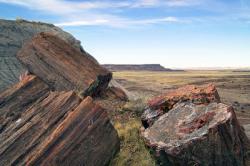
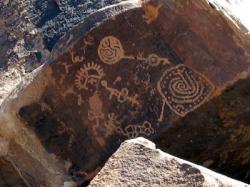 Petrified Forest National Park - The treasure trove of unique geology and archeology found in Petrified Forest National Park has just grown by the addition of some 26,000 acres to the park. The recent purchase of a privately-owned ranch within the park's authorized boundaries expands the protected area by about twenty-five percent. Preliminary surveys of the new property have shown potential for a number of archaeological sites including large, early basketmaker villages and phenomenal petroglyph sites. Acquisition of this land may significantly enhance knowledge of early peoples of the area.
Petrified Forest National Park - The treasure trove of unique geology and archeology found in Petrified Forest National Park has just grown by the addition of some 26,000 acres to the park. The recent purchase of a privately-owned ranch within the park's authorized boundaries expands the protected area by about twenty-five percent. Preliminary surveys of the new property have shown potential for a number of archaeological sites including large, early basketmaker villages and phenomenal petroglyph sites. Acquisition of this land may significantly enhance knowledge of early peoples of the area.
http://www.nationalparkstraveler.com/2011/09/major-addition-petrified-forest-national-park-may-hold-significant-features8746
- CHINE – Grande Muraille - A Chinese archaeologist has revealed that the Great Wall of China has several parallel walls, contrary to the popular perception that views the structure as a single continuous block. The Great Wall was originally built in the Warring States Period (475 BC - 206 BC) to defend China from nomadic tribes. The Great Wall’s survey team Director Duan Jingbo revealed that several sections of the structure have shown two to three smaller walls which are built parallel to the main wall, Xinhua reports. He said a section of the wall located in Shaanxi province is composed of two parallel walls, which made it more defensive and thus helped military leaders to garrison troops more effectively. The Chinese government began an intensive Great Wall survey in 2006, to investigate the overall condition of the structure.
http://www.dnaindia.com/scitech/report_china-s-great-wall-has-multiple-walls-instead-of-one-says-archaeologist_1584918
- USA – Noatak - University of Alaska Fairbanks officials say researchers have discovered ancient artifacts in northwest Alaska. The discovery of several decorated clay discs was made this summer while archaeologists excavated at the site of previously discovered petroglyphs and three prehistoric dwellings at Noatak National Preserve. The team assembled at the site discovered almost 40 years ago to document the rock art and to excavate partially underground house pits. Museum of the North archaeologist Scott Shirar says in a news release the discs appear to be a unique artifact for Alaska. He says the excavation covered only a small area and the discovery indicates there are probably more artifacts.
http://www.therepublic.com/view/story/18dd2c20b5b843e2b0b11540b675eb32/AK--Alaska-Artifacts/
- CANADA – Baie de Mercy - Des archéologues qui ont plongé jusqu'à l'épave d'un navire qui a fait naufrage au 19e siècle sont revenus avec un butin qui, espèrent-ils, les aideront à en apprendre davantage sur l'expédition perdue de Franklin. Avec un enthousiasme débordant, des employés d'expérience de Parcs Canada ont montré fièrement, jeudi à Ottawa, des pièces de fixation, des bordés de carène en cuivre, un fusil qui appartenait à la marine britannique et datant de 1842, ainsi qu'une paire de souliers, des artéfacts qu'ils ont trouvés sur le pont du HMS Investigator, dont l'épave se trouve à huit mètres sous les eaux glaciales de l'Arctique. Le HMS Investigator, un navire de commerce, avait effectué deux voyages en Arctique à la recherche de l'expédition perdue de sir John Franklin. Il avait toutefois été abandonné, en 1853, après s'être coincé dans les glaces autrefois impénétrables de l'Arctique. Le HMS Investigator a été découvert l'année dernière lors de recherches menées dans la baie Mercy, au large de l'île Banks, dans la mer de Beaufort.
http://www.branchezvous.com/info/actualite/2011/09/des_artefacts_trouves_sur_le_hms_investigator_7946140.html
- FRANCE – 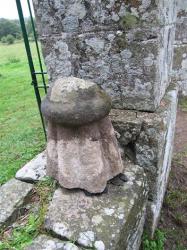 Plévin - À quelques jours du pardon de Plévin une pièce archéologique vient d’être découverte. Victor Lorvellec, propriétaire de la ferme où se déroulera la manifestation, était intrigué par une pierre qui permettait la fermeture de la chapelle. Il s’est souvenu des propos d’un archéologue qui lui avait fait part de son idée sur l’origine de cette pierre. Victor Lorvellec a creusé cette semaine et a mis au jour une pièce de l’époque romaine représentant un phallus, symbole de la fécondité.
Plévin - À quelques jours du pardon de Plévin une pièce archéologique vient d’être découverte. Victor Lorvellec, propriétaire de la ferme où se déroulera la manifestation, était intrigué par une pierre qui permettait la fermeture de la chapelle. Il s’est souvenu des propos d’un archéologue qui lui avait fait part de son idée sur l’origine de cette pierre. Victor Lorvellec a creusé cette semaine et a mis au jour une pièce de l’époque romaine représentant un phallus, symbole de la fécondité.
http://www.ouest-france.fr/actu/actuLocale_-Archeologie-un-phallus-de-pierre-decouvert-a-Sant-Diboan_40798-1905532------22070-aud_actu.Htm
- FRANCE – 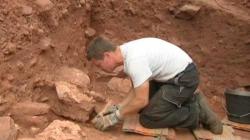 Mutzig - Un vrai travail de fourmi qui a permis d'exhumer des trésors du paléolithique, ossements de mamouth, outils qui nous éclairent chaque jour un peu plus sur la vie quotidienne de l'Homme de Néanderthal, grand chasseur de la plaine d'Alsace. Mais un travail de longue haleine pour une quizaine de chercheurs suisse, allemands et français. Une découverte extremement rare pour cette période du Paléolithique. Le chantier de Mutzig est loin d'avoir révéler tous ses secrets. Il faudra 10 ans de travail pour sonder l'ensemble des niveaux de gisements.
Mutzig - Un vrai travail de fourmi qui a permis d'exhumer des trésors du paléolithique, ossements de mamouth, outils qui nous éclairent chaque jour un peu plus sur la vie quotidienne de l'Homme de Néanderthal, grand chasseur de la plaine d'Alsace. Mais un travail de longue haleine pour une quizaine de chercheurs suisse, allemands et français. Une découverte extremement rare pour cette période du Paléolithique. Le chantier de Mutzig est loin d'avoir révéler tous ses secrets. Il faudra 10 ans de travail pour sonder l'ensemble des niveaux de gisements.
VIDEO = http://alsace.france3.fr/info/mutzig-chantier-de-fouilles-archeologiques-70330987.html?onglet=videos
- FRANCE – Perros Guirec - Une équipe de plongeurs du Département des recherches archéologiques subaquatiques et sous-marines (DRASSM), affilié au ministère de la Culture vient de mener une mission d’exploration en baie de Perros-Guirec. Ils étaient à la recherche des vestiges d’une épave du XVIIIe ou XIXe siècle dont la présence est attestée par la découverte de divers objets, notamment des boulets de canons, retrouvés par Roland Le Mével, un plongeur perrosien. Mais ces recherches sont restées vaines, et, après trois jours de fouilles, les archéologues ont dû renoncer : « Le secteur est vaste ; le cœur du site n’a pas été trouvé, et le mauvais temps de mardi a retardé les investigations », selon Olivia Hulot, responsable de la mission.
http://www.ouest-france.fr/actu/actuLocale_-A-la-recherche-d-une-epave-en-baie-de-Perros-Guirec_40805-1983892------22113-aud_actu.Htm
- ROYAUME UNI – 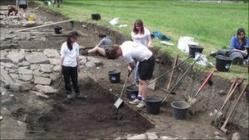
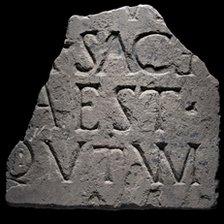 Binchester - Dr David Petts, from Durham University's Department of Archaeology, said: "This year's excavations at Binchester have proved very exciting. "We have gained a new understanding of life in County Durham in the twilight years of the Roman Empire." Binchester was established in the later 1st Century and was once the largest Roman fort in County Durham. Other structures and artefacts found by the team indicate continued occupation at the site into the early medieval period.and show evidence from Binchester of large-scale leather production dating to the late 4th and early 5th Century. They also uncovered an important inscription from the 2nd Century suggesting the presence of a small shrine at the site. The excavations featured on the programme were carried out as part of a five-year project at the site.
Binchester - Dr David Petts, from Durham University's Department of Archaeology, said: "This year's excavations at Binchester have proved very exciting. "We have gained a new understanding of life in County Durham in the twilight years of the Roman Empire." Binchester was established in the later 1st Century and was once the largest Roman fort in County Durham. Other structures and artefacts found by the team indicate continued occupation at the site into the early medieval period.and show evidence from Binchester of large-scale leather production dating to the late 4th and early 5th Century. They also uncovered an important inscription from the 2nd Century suggesting the presence of a small shrine at the site. The excavations featured on the programme were carried out as part of a five-year project at the site.
http://www.bbc.co.uk/news/uk-england-tees-14851785